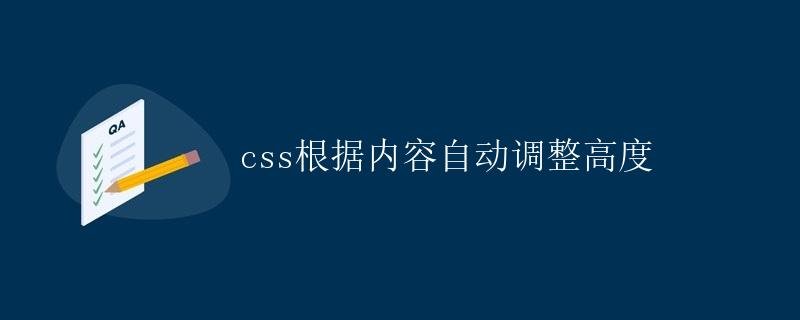CSS automatically adjusts height based on content
CSS automatically adjusts height based on content
 In web design and development, you often encounter the problem of an element’s height changing as content increases, but the exact height of that content isn’t always certain. In this case, if you fix the element’s height, the content might overflow or become too empty, affecting the page’s aesthetics and user experience. So, how can you make an element automatically adjust its height based on its content?
In web design and development, you often encounter the problem of an element’s height changing as content increases, but the exact height of that content isn’t always certain. In this case, if you fix the element’s height, the content might overflow or become too empty, affecting the page’s aesthetics and user experience. So, how can you make an element automatically adjust its height based on its content?
In this article, we’ll introduce several methods to achieve this effect, primarily using CSS. We’ll also compare the pros and cons of these methods to help you choose the solution that’s right for your project.
Method 1: Use the height attribute set to auto
The first method is to simply set the element’s height to auto. auto is a special value in CSS that indicates that the height is determined by the height of the content. When the element’s height attribute is set to auto, the element will automatically adjust to the actual height of the content.
<!DOCTYPE html>
<html>
<head>
<style>
.box {
border: 1px solid #000;
height: auto;
}
</style>
</head>
<body>
<div class="box">
Lorem ipsum dolor sit amet, consectetur adipiscing elit. Nullam laoreet sagittis eros, et porttitor nisi posuere nec. Donec nec velit eu sapien maximus finibus. Pellentesque habitant morbi tristique senectus et netus et malesuada fames ac turpis egestas.
</div>
</body>
</html>
In the above code, we add a class named box to a DIV and set its height to auto. As you can see, the element’s height does indeed adapt to the amount of content.
Advantages: Simple and straightforward, very easy to implement.
Disadvantages: Due to the browser’s default style and the height limit of the parent element, the element’s height may not fully adjust automatically to the content.
Method 2: Using the max-height Property
The second method is to use the max-height property. The max-height property sets the maximum height of an element. Combined with the overflow property, it controls how the element’s content should behave when it exceeds the maximum height.
<!DOCTYPE html>
<html>
<head>
<style>
.box {
border: 1px solid #000;
max-height: 200px;
overflow: auto;
}
</style>
</head>
<body>
<div class="box">
Lorem ipsum dolor sit amet, consectetur adipiscing elit. Nullam laoreet sagittis eros, et porttitor nisi posuere nec. Donec nec velit eu sapien maximus finibus. The Pellentesque habitant is a tristique senectus and netus and malesuada fames ac turpis egestas.
</div>
</body>
</html>
In the code above, we set a maximum height of 200px for the box element and set the overflow property to auto. This way, when the content exceeds the maximum height, scroll bars are automatically added, preventing overflow.
Advantages: Allows you to control the maximum height of an element, preventing content from growing indefinitely and causing a messy page layout.
Disadvantages: Requires manual setting of the maximum height, and may not automatically adjust based on the content.
Method 3: Using Flex Layout
The third method is to use flex layout. Flex layout is a powerful layout method that can achieve a variety of complex layout effects.
<!DOCTYPE html>
<html>
<head>
<style>
.container {
display: flex;
flex-direction: column;
}
.box {
border: 1px solid #000;
flex: 1;
}
</style>
</head>
<body>
<div class="container">
<div class="box">
Lorem ipsum dolor sit amet, consectetur adipiscing elit. Nullam laoreet sagittis eros, et porttitor nisi posuere nec. Donec nec velit eu sapien maximus finibus. The purus odio fermentum est, sit amet varius massa diam a elit. Pellentesque habitant morbi tristique senectus et netus et malesuada fames ac turpis egestas.
</div>
</div>
</body>
</html>
In the above code, we first apply flex layout to a parent element, container, and set its flex-direction property to column, indicating that the child elements will be arranged vertically. Then, we set flex: 1 on the child element, box, indicating that the child element will automatically adjust its height based on its content.
Advantages: Simple implementation, and element height automatically adjusts based on its content.
Disadvantages: Some browsers may not support flex layout, so you need to choose a suitable layout based on project compatibility.
In summary, automatically adjusting the height based on content is a common web page layout requirement, which can be achieved through the methods listed above. Choosing a method depends on the specific situation and project requirements.